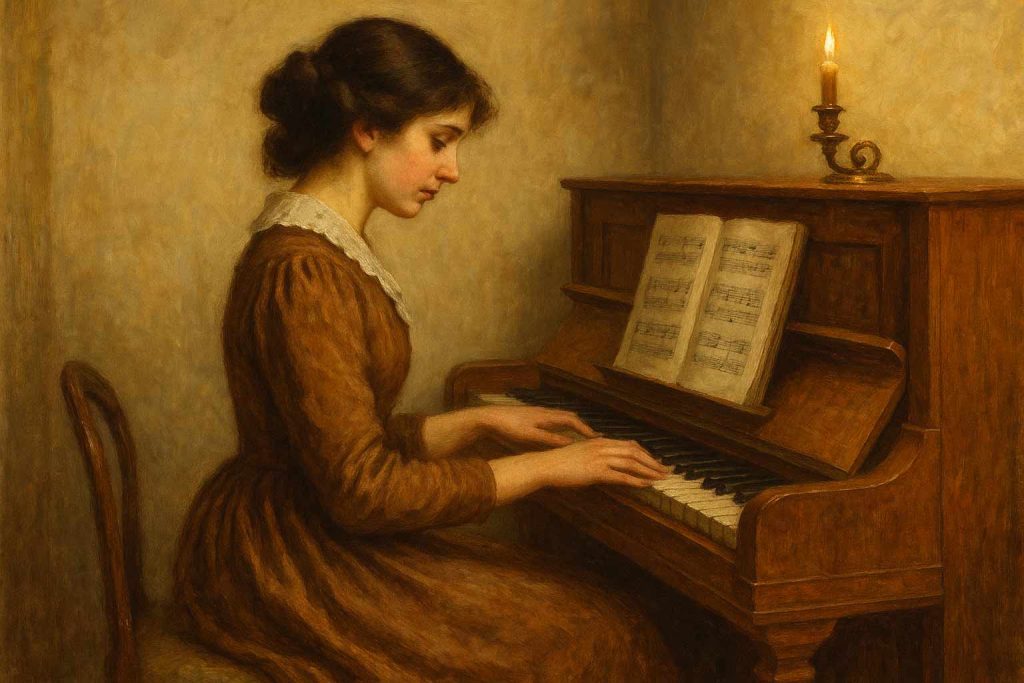For centuries the piano has been a testing ground for brilliance.
Its 88 keys offered endless possibilities, but not always equal opportunities.
Many women pianists whose talents as performers and composers rivalled that of their male peers, were silenced, restricted, or overshadowed.
In the 18th and 19th centuries especially, society allowed women to play at home, but rarely on stage, and almost never to be recognised as composers.
Three women show this struggle clearly: Maria Anna Mozart, Fanny Mendelssohn, and Clara Schumann.
Each was immensely talented, yet each was eclipsed by a man whose name is now world-famous.
Maria Anna Mozart: The Sister Overshadowed
When we think of the Mozart family, we think of Wolfgang Amadeus, the boy genius paraded before Europe’s courts. But before Wolfgang dazzled Vienna and Paris, his elder sister Maria Anna — known in the family as “Nannerl” — was every bit his equal.
Born in 1751, she was four years older than her brother. Both were taught by their father Leopold and toured together as children, performing piano duets for aristocrats. Many accounts praised her skill; some even said she was the more disciplined pianist.
But society drew a line. A girl prodigy could perform, but a grown woman could not tour alone.
By her late teens, her career was cut short. Marriage and home life were judged more appropriate. Her younger brother entered history; her own compositions — which did exist — were lost or ignored.
The piano, once her passport to European courts, was confined to the drawing room. Her story shows how talent can vanish not from lack of ability but from society’s rules and expectations.
Fanny Mendelssohn: The Sister in the Shadows
A generation later in Berlin, Fanny Mendelssohn (1805–1847) faced the same barriers. The eldest in a wealthy family, she displayed prodigious musical gifts from an early age. She and her younger brother Felix studied with the same teachers, and her ability equalled his.
But her father’s words made the family’s attitude clear: “Music will perhaps become Felix’s profession, while for you it can and must only be an ornament.” Music, for a girl, was acceptable as a pastime but not as a career.
Fanny still composed prolifically — more than 450 works, including piano cycles and songs. Some were even published under Felix’s name. While he acknowledged her talent, he accepted the norms that prevented her from seeking recognition.
Only shortly before her early death at 41 did Fanny publish a few works under her own name.
Today, scholars are rediscovering her music, recognising that the Mendelssohn legacy belonged not just to Felix. Many piano pieces once attributed to him may in fact carry her silenced voice.
Clara Schumann: Virtuoso, Wife, and Sacrificed Composer
Clara Schumann (1819–1896) was different. She achieved international fame in her lifetime as a pianist, performing from her teens and hailed as one of the 19th century’s greatest virtuosos.
Yet her career still bore the marks of inequality. Her marriage to Robert Schumann shifted her role: wife, muse, and supporter, while his work took precedence. Clara composed — her Piano Concerto and songs are original and distinctive — but she curbed her ambition, writing that “a woman must not desire to compose.”
After Robert’s illness and early death, Clara supported her family by touring relentlessly. She kept Robert’s reputation alive by performing his works and championed Brahms. But her own compositions were sidelined.
Despite her towering skill, history remembers her more as Robert’s interpreter than as a composer. Clara proved that women could be world-class performers, but her creative voice was still confined.
Barriers Then and Now
From Maria Anna to Fanny to Clara, the pattern is clear: women could be prodigious, accomplished, even famous performers — but they were blocked from being recognised as creators.
Things have changed. The 20th century saw female pianists emerge as international stars: Myra Hess, Martha Argerich, Mitsuko Uchida. Conservatories opened to women, and female composers gained serious recognition.
Yet hurdles remain. Studies show that works by women still make up only a tiny fraction of orchestral programs. Female pianists report being underestimated or steered toward “sensitive” repertoire.
In popular music too, women at the piano still face scrutiny over image in a way their male counterparts rarely do.
Progress is real, but equality is not complete.
Contemporary Trailblazers
Today, some women have pushed through the barriers that once held back Maria Anna, Fanny, and Clara:
Martha Argerich — The Argentine virtuoso is hailed as one of the greatest pianists alive. Her fiery interpretations of Chopin, Liszt, and Prokofiev are benchmarks for anyone, proving that artistry is not defined by gender.
Hélène Grimaud — The French pianist has built a career as a performer, author, and environmental activist. Known for her searching interpretations of Brahms and Rachmaninoff, she embodies the kind of multidimensional artistry Clara Schumann could only have dreamed of.
Gabriela Montero — The Venezuelan pianist and composer has made improvisation — long considered a male-dominated art — her trademark. She dazzles audiences with extemporisations on suggested themes, proving that creativity at the piano is alive, spontaneous, and boundless.
These women, and many others, show that the struggles of their predecessors were not wasted. Their talent was restricted, but it paved the way for future equality.
Honouring Pioneering Women Pianists
For anyone at the piano today, it’s worth remembering that the instrument has long been tied to questions of gender and access.
The struggles of past women pianists remind us how much talent was lost to prejudice — and how much resilience was shown in the face of it.
When you sit at the keyboard to practise or learn a piece, you become part of this long history.
The piano has been a stage for queens and rebels, prodigies and protestors, silenced voices and triumphant ones.
By celebrating Maria Anna Mozart, Fanny Mendelssohn, and Clara Schumann, we honour not only their curtailed careers but also the doors they opened for those who followed.



